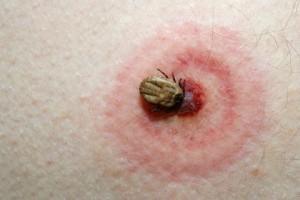Each year, more than 300,000 cases of Lyme disease are reported  to the Centers for Disease Control(CDC), making it the most commonly reported tick-borne illness in the United States. The new estimate suggests that the total number of people diagnosed with Lyme disease is roughly 10 times higher than the yearly reported number.
to the Centers for Disease Control(CDC), making it the most commonly reported tick-borne illness in the United States. The new estimate suggests that the total number of people diagnosed with Lyme disease is roughly 10 times higher than the yearly reported number.
“We know people can prevent tick bites through steps like using repellents and tick checks. Although these measures are effective, they aren’t fail-proof and people don’t always use them,” said Lyle R. Petersen, M.D., M.P.H, director of CDC’s Division of Vector-Borne Diseases. “We need to move to a broader approach to tick reduction, involving entire communities, to combat this public health problem.”
This community approach would involve homeowners trying to kill ticks in their own yards, and communities addressing a variety of issues. These issues include rodents that carry the Lyme disease bacteria, deer that play a key role in the ticks’ life cycle, suburban planning, and the interaction between deer, rodents, ticks, and humans. All must be addressed to effectively fight Lyme disease.
Most Lyme disease cases reported to CDC through national surveillance are concentrated heavily in the Northeast and upper Midwest, with 96 percent of cases in 13 states. Lyme disease is transmitted to humans through the bite of infected black legged ticks. Typical symptoms include fever, headache, fatigue, and a characteristic skin rash. If left untreated, infection can spread to joints, the heart, and the nervous system.
CDC recommends people take steps to help prevent Lyme disease and other tickborne diseases by:
-
Wearing repellent
-
Checking for ticks daily
-
Showering soon after being outdoors
-
Calling your doctor if you get a fever or rash
For more information on Lyme disease, visit www.cdc.gov/lyme.
Source: Centers for Disease Control, CDC

